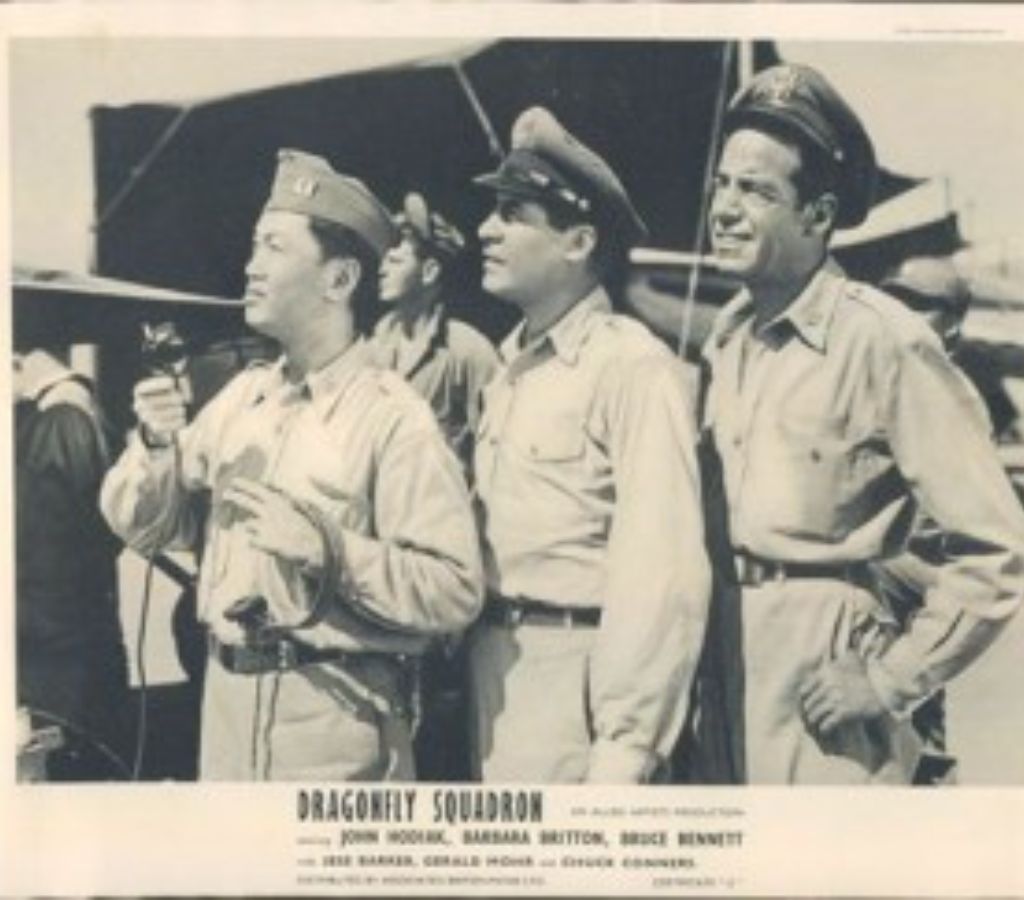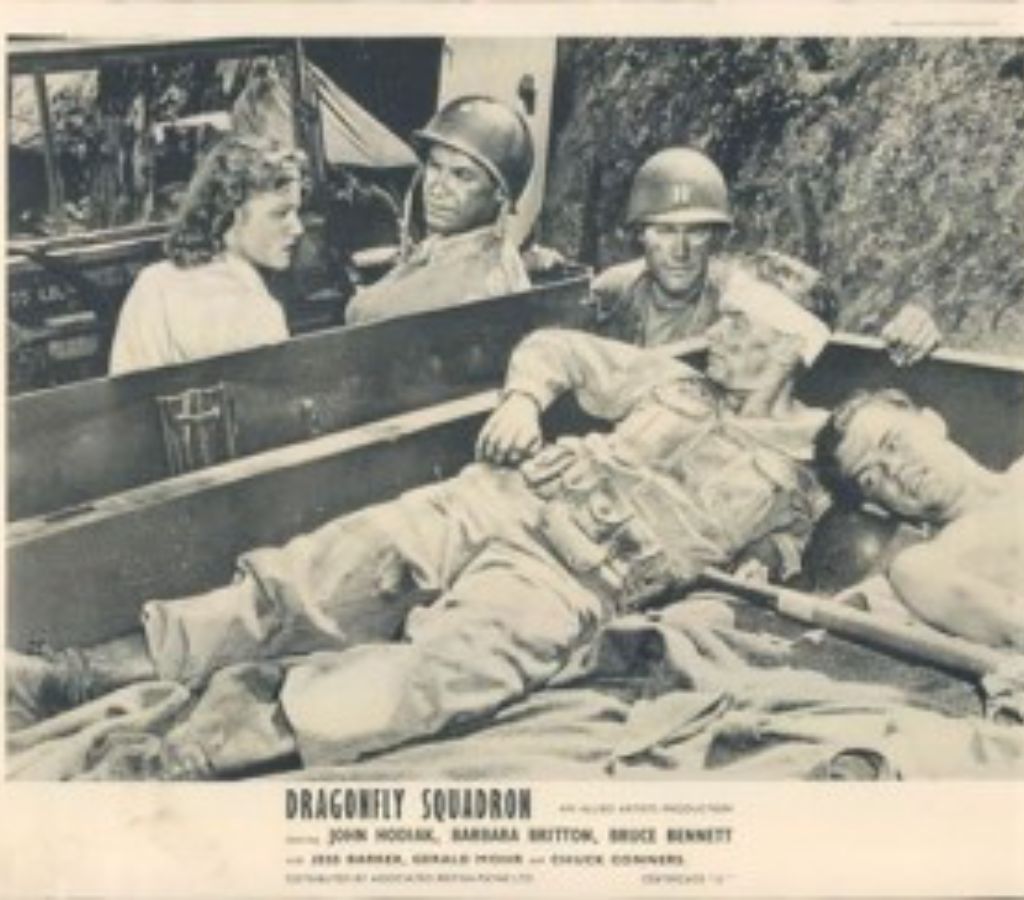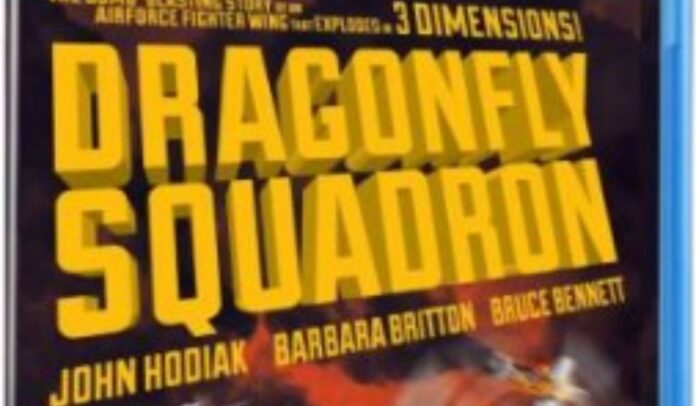Experience the cinematic magic in the 3-D Blu-ray Review of the timeless classic “Dragonfly Squadron” (1954).
What a pleasant surprise! Dragonfly Squadron (1954) is rather typical as a movie, following a familiar war film narrative with well-known characters and genre clichés.
Including a strict and humorless commanding officer, a cunning second-in-command, and a subordinate holding a personal grudge against the commanding officer.
Also, a woman is caught in an emotional conflict between her dedicated, self-sacrificing doctor husband and the commanding officer she loves.
3-D Blu-ray Review: Dragonfly Squadron (1954)
The release of Dragonfly Squadron’s 3-D Film Archive restoration by Olive Films holds significant historical importance. While the film was initially shot in 3-D, it was never released in that format.
By its release in March 1954, CinemaScope, a new widescreen and stereophonic sound format promoted by 20th Century Fox, had become the prevailing technology.
Despite being produced by the lesser-known Monogram/Allied Artists, a Poverty Row company, the original 3-D harmful film elements endured.
However, a 3-D Blu-ray release for a relatively obscure film like Dragonfly Squadron was nearly nonexistent until Bob Furmanek and Greg Kintz from the 3-D Film Archive advocated its stereoscopic restoration.

For enthusiasts of older 3-D films, Furmanek and Kintz offer a valuable service by preserving, restoring, and making accessible 3-D features and shorts that might otherwise be lost to time.
Classic 3-D movies seldom make a theatrical comeback.
When they do, it’s usually limited to well-known titles like House of Wax (1953) or Alfred Hitchcock’s Dial M for Murder (1954), with a few others, such as Creature from the Black Lagoon, making less frequent appearances.
This situation is reminiscent of a press conference where Jackie Gleason announced the redistribution of “Lost” Honeymooners episodes.
When asked about his decision, Gleason wittily remarked, “I’m sick of watching those other Honeymooners,” referring to the endlessly rerun “Classic 39” episodes.
The same holds for classic 3-D films, elevating even a relatively minor movie like Dragonfly Squadron to a significant viewing event.
Set just before and during the onset of the Korean War in May 1950, Dragonfly Squadron’s narrative parallels World War II films like Flying Tigers, They Were Expendable, and Back to Bataan, with a hint of Go for Broke! (1951).
The protagonist, Maj. Mathew “Matt” Brady (played by John Hodiak) is a distinguished Air Force instructor temporarily grounded for medical reasons.
His assignment involves shaping inexperienced American and South Korean pilots at Kongku Air Base within three weeks. Among the fledgling pilots is James Hong, although he remains uncredited.
As the story unfolds, Brady discovers that his former fiancée, Donna Cottrell (Barbara Britton), is also stationed at the base.
Their plans to marry were disrupted when she learned that her supposedly deceased husband, Stephen (Bruce Bennett), a prisoner tortured in Indo-China, was alive.
Despite her emotional attachment to Brady, Donna remains devoted to Stephen, who, despite mutilated hands, is portrayed as a saintly and dedicated physician.
The narrative introduces additional familiar plot elements, such as Capt.’s resentment.
Vendors (Harry Lauter) towards Brady, holding him responsible for the death of their mutual best friend in a plane crash.
Other genre stereotypes include the young married couple, Capt. Woody Taylor (John Lupton) and Anne (Pamela Duncan) are eager to return to the States after two years stationed in Korea.
Brady’s best friend, Capt. MacIntyre (Gerald Mohr) adds a touch of friendliness with his wisecracks, contrasting with Brady’s by-the-book stiffness.
The squadron also features the expected southern character (Fess Parker), an elfish flyer (Eddie Firestone, uncredited) perpetually concealing a dog under his leather jacket, and a quietly efficient junior officer (Adam Williams) whose helmet practically screams “Doomed.”

Dragonfly Squadron’s storyline might be familiar, but its execution, skillfully handled by the proficient B-movie director Lesley Selander, remains engaging and well-paced given the nature and budget of the film.
The reported cost of approximately $300,000, though considered inexpensive by major studio standards, slightly surpasses the typical budget of Monogram/Allied Artists programmers from that era.
The film’s appearance benefits from using the Air Force and Marine Corps. Hardware, giving it a more expensive look, complemented by Selander’s adept direction that enhances the film’s modest refinement.
Employing stock shots, some in regular 2-D, with minimal optical effects, Dragonfly Squadron showcases its best 3-D effects during a battle and evacuation near the conclusion.
These scenes, executed with on-set special effects on a full scale, contribute to the overall visual appeal of the film.
The presence of accomplished actors adds to the film’s quality.
While John Hodiak, a legitimate star albeit on the decline, belonged to the cohort of leading men established during the early 1940s, Fess Parker and, later in the narrative, Chuck Connors, emerge as up-and-coming talents exuding charisma and clearly on an upward trajectory.
The cast also includes capable actors familiar with the grind of cheap films, such as Bruce Bennett, Gerald Mohr, Adam Williams, and Frank Ferguson.
Barbara Britton, a striking actress, saw her career gradually decline, and she notably co-starred in the first 3-D feature of the 1950s, Bwana Devil (1952), which initiated the 3-D craze.
Contrary to the common misconception that ’50s 3-D movies were characterized by over-the-top effects, Dragonfly Squadron, directed by Selander, avoids such exaggeration.
Despite the absence of flashy effects, Selander thoughtfully stages many scenes to emphasize multiple depth planes. For instance, in a bar, chairs are stacked on tables, and half-empty glasses on the bar enhance the depth perception.
The film’s sets feature doorways leading to back rooms, deviating from the mundane art direction of typical Monogram movies like Louie’s Sweet Shop in the Bowery Boys pictures.
While it may not be a grand showcase for 3-D, the execution is commendable. Additionally, scenes set in darkened rooms provide an intriguing perception of depth.
Dragonfly Squadron is showcased in its original 1.66:1 widescreen format.
Although the black-and-white film exhibits some speckling, an unexpected element includes subtle, barely noticeable bits of color, such as on an actor’s nose, which I assume were utilized for image alignment during postproduction.
Overall, the visual quality is commendable, with the 3-D effect consistently flawless.
Despite the modest budget of Dragonfly Squadron, the utilization and final appearance of ordinary 3-D scenes in this film are, in some aspects, more impressive than the unimaginative use of the process in many contemporary 3-D films.
This observation aligns with the experience of another cost-effective 3-D title, Man in the Dark, now available on Blu-ray.
The presentation thoughtfully includes the film’s original intermission card, adding a nice touch.
While some significant 3-D movies were presented with stereophonic sound, Dragonfly Squadron consistently maintained a mono audio format, which is presented here and is satisfactory, comparable to other mid-’50s mono releases.
The film’s original 3-D title cards, previously assumed lost, have been reinstated.
The Blu-ray edition features the 3-D version and includes a standard 2-D version of the film, accompanied by a lively 2-D trailer.
Although Dragonfly Squadron may not be considered among the illustrious Hollywood war movies, its release in 3-D deserves the accolades bestowed upon Bob Furmanek and Greg Kintz.
With this release, they have effectively demonstrated how titles like Dragonfly Squadron can be restored and presented in flawless 3-D at a reasonable cost.
This success will likely encourage the production of more 3-D Blu-ray releases akin to this one.

